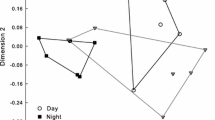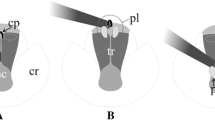Abstract
The pollination ofVigna vexillata (Leguminosae-Papilionoideae) by a carpenter bee,Xylocopa gualanensis (Hymenoptera-Anthophoridae) was studied in a secondary vegetation in Costa Rica. The bees were observed foraging onV. vexillata only in early mornings. Visits on individual flowers lasted about 7–8 seconds. Flower—pollen vector interactions are described and illustrated. By its pressure on the left-hand wing- and keel-petal in the asymmetrical flower, the weight of the bee causes the upper bearded part of the style along with the upper free parts of the stamens to slip out of the rigid keel-beak, “hugging” the bee over the dorsal part of its head and thorax. The occurrence of nototribic pollination inVigna and related genera is discussed.
Similar content being viewed by others
References
Arroyo, M. T. K., 1981: Breeding systems and pollination biology inLeguminosae. — InPolhill, R. M., Raven, P. H. (Eds.): Advances in Legume Systematics, pp. 723–769. — Kew: Royal Botanic Gardens.
Elliot, G. F. Scott, 1891: Notes on the fertilization of South African and Madagascar flowering plants. — Ann. Bot.5, 333–405.
Faegri, K., van der Pijl, L., 1979: The Principles of Pollination Ecology, ed. 3. — Oxford, New York: Pergamon Press.
Frankie, G. W., Daly, H. V., 1983:Xylocopa gualanensis (Xicote, Avispa Carpintera, Carpenter Bee). — InJanzen, D. H. (Ed.): Costa Rican Natural History, pp. 777–779. — Chicago: University of Chicago Press.
—, 1977: Scent marking of passion flowers in Texas by females ofXylocopa virginica texana (Hymenoptera: Anthophoridae). — J. Kansas Ent. Soc.50, 613–624.
Free, J. B., 1970: Insect Pollination of Crops. — London, New York: Academic Press.
Lackey, J. A., 1981:Phaseoleae. — InPolhill, R. M., Raven, P. H. (Eds.): Advances in Legume Systematics, pp. 301–327. — Kew: Royal Botanic Gardens.
Lindman, C. A. M., 1902: Die Blüteneinrichtungen einiger südamerikanischer Pflanzen, I.Leguminosae. — Bih. Kongl. Svenska Vetensk.-Akad. Handl.27, 1–63.
Maréchal, R., Mascherpa, J.-M., Stainier, F., 1978: Étude taxonomique d'un group complexe d'espèces des genresPhaseolus etVigna (Papilionaceae) sur la base de données morphologiques et polliniques, traitées par l'analyse informatique. — Boissiera28, 1–273.
National Academy of Sciences, 1979: Tropical legumes: resources for the future. — Washington, D.C.
Pijl, L. van der, 1954:Xylocopa and flowers in the tropics, I–III. K. Nederlandse Akad. Wetens. Proc., Ser. C,57, 413–423, 541–562.
Sage, R. D., 1968: Observations on feeding, nesting and territorial behaviour of carpenter bees (genusXylocopa) in Costa Rica. — Ann. Ent. Soc. Am.61, 884–889.
Tosi, J. A. Jr., 1969: Mapa ecológico de Costa Rica. — San José: Centro Científico Tropical.
Verdcourt, B., 1970: Studies in theLeguminosae-Papilionoideae for the “Flora of Tropical East Africa”: IV. — Kew Bull.24, 507–569.
Author information
Authors and Affiliations
Rights and permissions
About this article
Cite this article
Hedström, I., Thulin, M. Pollination by a hugging mechanism inVigna vexillata (Leguminosae-Papilionoideae). Pl Syst Evol 154, 275–283 (1986). https://doi.org/10.1007/BF00990129
Received:
Issue Date:
DOI: https://doi.org/10.1007/BF00990129




